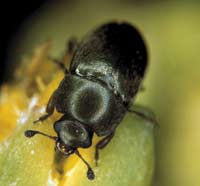OSR pollen beetle treatment thresholds re-examined

Pollen beetles soon get oilseed rape growers reaching for the sprayer. But new research suggests that’s an over-reaction. Andrew Blake reports
Far too much winter oilseed rape gets treated unnecessarily against pollen beetle. And given that resistance to pyrethroid insecticides is real, albeit rare in the UK yet, a new HGCA project is under way to help growers better assess the need for spraying against the pest.
Adult pollen beetles, which start to fly at 15C, are particularly attracted to the crop’s yellow flowers. But the damage they do occurs much earlier, at the green/yellow stage, when they bite into the buds to feed on the pollen, notes ADAS’s Steve Ellis. “It leads to blind stalks, ie without pods, that can be confused with frost damage.”
Until now the green/yellow bud thresholds to justify spraying have been 15 and five beetles per plant in well grown and backward winter crops, respectively, and three per plant in spring rape. But the figures are apparently quite arbitrary, based on “rule of thumb” assessments by ADAS many years ago.
“There’s now a lot of debate about them,” says Dr Ellis.
More worryingly, it seems growers take little notice of them, tending to spray irrespective of beetle counts.
Over the past 10 years in winter crops the numbers of beetles per plant never got above threshold level and only occasionally so in spring crops. Yet very large areas, usually well over half the national crop, got treated with insecticide. Given that unwarranted spraying may encourage resistance, that’s undesirable, he says.
“Clearly something’s wrong. We have to ask whether people believe the thresholds.”
It’s against that background the new project set out to re-evaluate the levels, in the knowledge the crop is inherently tolerant of pest attacks.
“We want to find out whether the thresholds are out of date in relation to modern varieties,” he says. “Does where you assess beetles in the field affect your estimate of numbers, are restored hybrids at greater risk and can we use early spring canopy size to predict the risk?”
Specifically the work’s objectives are to quantify flower bud loss from beetle attack and to pin down the relationship between early canopy size, flower number and numbers of pods set, he says.
It also aims to develop a way to predict yield loss based on variety and crop size, validate risk predictions and investigate pollen distribution in the field, as this is likely to affect any estimate of beetle numbers resulting from crop monitoring.
In its first of three years of the £112,000 project, six varieties, both conventional and hybrid, were sown at ADAS High Mowthorpe and Rosemaund.
There was no significant difference between varieties in terms of the ratio of pods to flower numbers, suggesting no inherent difference between conventional and hybrid varieties in their ability to tolerate pollen beetle attack.
The results confirmed that all varieties produced far more flowers than needed. “A good crop produces about 20,000/sq m, but only 10,000 are required for optimum yield,” says Dr Ellis. So about 50% could afford to be lost.
At the same time pot trials, subjecting plants enclosed in perforated polythene bags to different populations of beetles, were carried out in the fields. Alongside an uninfested pot, others with 5, 10, 15, 20 and 50 beetles introduced per plant were assessed.
The results showed that on average a single beetle can destroy nine buds.
On that basis it would, in theory, need more than 1100/sq m before the surplus flowers were destroyed.
“That’s a very high number and clearly more than the current 15 a plant threshold. But the tolerance of crops will also depend on plant populations, and that must also be taken into account.”
This year’s work has extended the sowings to five seed rates of winter and spring varieties. The intention is to manipulate plant numbers to see how this may affect their canopies and the number of excess flowers and pods, notes Dr Ellis. The semi-field pot studies will also be continued, including a single beetle introduction.
“We also plan to monitor beetle numbers in 10-20 fields to see whether their distribution affects how we should assess them for threshold purposes.“
The work is part of a wider series of planned projects to reassess spray thresholds across a wide range of pests and diseases, he notes.

